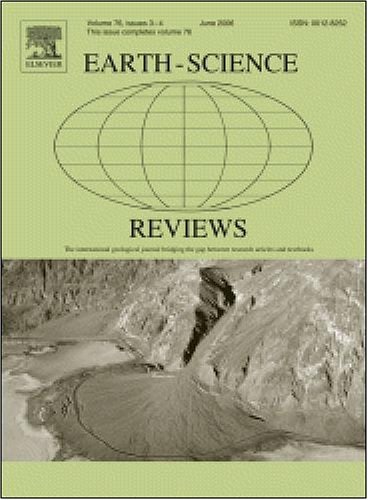A revisit to continental collision between India and Asia
IF 10.8
1区 地球科学
Q1 GEOSCIENCES, MULTIDISCIPLINARY
引用次数: 0
Abstract
The India-Asia continental collision and the uplift of the Tibetan Plateau have long been attributed to continuous Cenozoic convergence with two generic assumptions: the ongoing India-Asia collision and the underthrusting of the Indian continent beneath the Tibet hinterland. This study presents a challenge to the two assumptions through an integrative analysis of geological, geophysical and geochemical data, mainly focusing on the duration of syn-collisional processes, the spatial range of syn-collisional effects, and the distinction in structure and composition between syn-collisional and post-collisional products. It turns out that the India-Asia collisional orogeny was short-lived in the Early Cenozoic without significant underthrusting of the Indian continent beneath the Tibet hinterland, and that the plateau uplift was governed by post-collisional mantle dynamics in the Late Cenozoic rather than the ongoing collision/subduction during the whole Cenozoic. The geological architecture of the Tibetan Plateau is highlighted as a mosaic of terranes that were accreted northwards from the Early Paleozoic through the Late Paleozoic to the Mesozoic. These terranes and their sutures were variably reactivated during the short-lived collision in the Early Cenozoic rather than forming as a singular collisional entity throughout the entire Cenozoic. The India-Asia collisional effects are the most prominent in the Himalayan and Gangdese orogens.
Inspection of key findings in the literature dismantles the traditional paradigms based on the two generic assumptions. Seismic tomography and helium isotope data constrain subduction of the Indian continent to depths of 200–300 km mainly beneath the Yarlung-Zangpo Suture that marks the southernmost margin of the Tibetan Plateau. Paleomagnetic discrepancies regarding the width of Greater India are resolved by emphasizing the cover-basement decoupling during soft collision and shallow subduction, limiting its underthrusting to short distances of ≤300 km. This reconciles geological shortening estimates with exaggerated paleomagnetic-derived convergence distances. A critical examination of petrological, structural and geochronological data partitions the formation of the Himalayan orogen into two stages. The first is the continental suturing from soft collision through hard collision to deep subduction, leading to crustal shortening through slice thrusting mainly at 55–45 Ma in the Early Cenozoic. The second is the post-collisional reworking due to upwelling of the asthenospheric mantle induced by foundering of the lithospheric mantle, resulting in crustal anatexis, emplacement of leucogranites and metamorphic core complexes, and domical uplift mainly at 30–10 Ma in the Late Cenozoic. The Himalaya-Tibet tectonic collage has behaved in a intracontinental setting in the Late Cenozoic when it uplifts due to the asthenospheric upwelling in response to the lithospheric foundering.
The present study demonstrates that the two generic assumptions for the India-Asia collision do not stand any more under close scrutiny and thus are essentially specious in previous studies. This has great bearing on the evolution of the Himalaya-Tibet tectonic collage in the Cenozoic. It casts doubt on the tectonic interpretation of paleomagnetic and seismic data with respect to the continental convergence and underthrusting between India and Asia. Many of geological and geochemical observations were interpreted under the two assumptions, overlooking a series of differences in temporal sequence, dynamic regime and geothermal gradient between the syn-collisional and post-collisional processes. Therefore, it is necessary to examine the rationality of geodynamic models for the processes, mechanisms and effects of the India-Asia collision and plateau uplift through prioritizing of the post-collisional processes over the syn-collisional effects. As such, this study offers transformative insights into the nature of continental tectonics at precedingly converged plate margins globally.
重新审视印度和亚洲之间的大陆碰撞
长期以来,印度-亚洲大陆碰撞和青藏高原的隆升被认为是新生代持续辐合的结果,有两种假设:持续的印度-亚洲碰撞和印度大陆在西藏腹地下方的逆冲。本研究通过对地质、地球物理和地球化学数据的综合分析,对这两种假设提出了挑战,主要集中在同步碰撞过程的持续时间、同步碰撞效应的空间范围以及同步碰撞和碰撞后产物的结构和成分的区别。结果表明,早新生代印度-亚洲碰撞造山运动是短暂的,在西藏腹地下没有明显的逆冲作用,高原隆升受晚新生代碰撞后地幔动力学的支配,而不是整个新生代持续的碰撞/俯冲作用。青藏高原的地质构造突出表现为从早古生代到晚古生代到中生代向北增生的一块块地体。这些地体及其缝合线在早期新生代短暂的碰撞中被反复激活,而不是在整个新生代形成一个单一的碰撞实体。喜马拉雅造山带和冈底斯造山带的印亚碰撞作用最为突出。对文献中关键发现的考察,拆解了基于两种一般假设的传统范式。地震层析成像和氦同位素数据将印度大陆的俯冲限制在200-300公里深处,主要在雅鲁藏布江缝合带下方,该缝合带标志着青藏高原的最南端。通过强调软碰撞和浅俯冲期间的盖-基底解耦,解决了大印度宽度的古地磁差异,将其下冲活动限制在≤300 km的短距离内。这使地质缩短估计与夸大的古地磁推导的收敛距离相一致。通过对岩石学、构造学和地质年代学数据的仔细研究,将喜马拉雅造山带的形成划分为两个阶段。一是早新生代主要发生在55 ~ 45 Ma,由软碰撞→硬碰撞→深俯冲的大陆缝合作用,通过切片逆冲作用导致地壳缩短。二是碰撞后的改造,主要发生在晚新生代30 ~ 10 Ma,岩石圈地幔沉降引起软流圈地幔上涌,导致地壳深熔,浅花岗岩和变质核杂岩侵位,以及圆齿隆升。喜马拉雅-西藏构造拼合在晚新生代表现为陆内环境,由于岩石圈沉降引起的软流圈上升流而抬升。本研究表明,关于印度-亚洲碰撞的两个一般假设在仔细审查下不再站得住脚,因此在以前的研究中基本上是似是而非的。这对新生代喜马拉雅—西藏构造拼合的演化有重要影响。它对古地磁和地震资料对印度和亚洲之间大陆辐合和逆冲构造的构造解释提出了怀疑。许多地质和地球化学观测都是在这两种假设下解释的,忽略了碰撞时和碰撞后过程在时间序列、动力机制和地温梯度上的一系列差异。因此,有必要通过优先考虑碰撞后的过程而不是碰撞时的作用来检验印度-亚洲碰撞和高原隆升过程、机制和影响的地球动力学模型的合理性。因此,这项研究提供了对先前全球板块边缘融合的大陆构造性质的变革性见解。
本文章由计算机程序翻译,如有差异,请以英文原文为准。
求助全文
约1分钟内获得全文
求助全文
来源期刊

Earth-Science Reviews
地学-地球科学综合
CiteScore
21.70
自引率
5.80%
发文量
294
审稿时长
15.1 weeks
期刊介绍:
Covering a much wider field than the usual specialist journals, Earth Science Reviews publishes review articles dealing with all aspects of Earth Sciences, and is an important vehicle for allowing readers to see their particular interest related to the Earth Sciences as a whole.
 求助内容:
求助内容: 应助结果提醒方式:
应助结果提醒方式:


